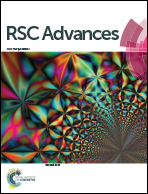New insights in partial nitrification start-up revealed by a model based approach†
Abstract
New insights in partial nitrification were revealed by using a model based approach to study the synergetic impact of various factors on partial nitrification. The traditional argument for using low DO (dissolved oxygen) in achieving partial nitrification is that AOB (ammonium oxidizing bacteria) has a higher DO affinity than NOB (nitrite oxidizing bacteria). However, the AOB was found to have a lower DO affinity (DO half saturation constant KO,AOB = 1.0 mg L−1) than NOB (KO,NOB = 0.35 mg L−1) in the nitrification process in this study. The rational for using a low DO concentration in this study was to slow down the ammonium removal, therefore increasing the FA (free ammonia) concentration for the inhibition of NOB. The optimal operational strategy for partial nitrification start-up was identified by the model based approach to be at a sludge retention time of 10 days, DO at 1.0 mg L−1 and pH at 8.2. The results indicated that a nitrite accumulation rate above 80% and complete ammonium removal can be achieved within 10 days of the start-up period by applying the model based optimization results.


 Please wait while we load your content...
Please wait while we load your content...